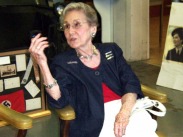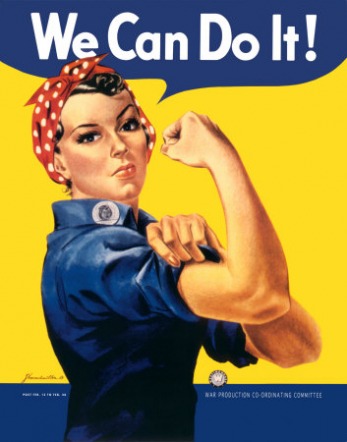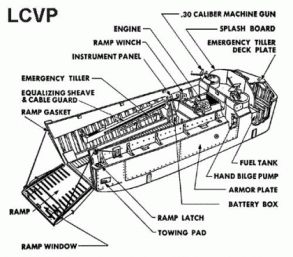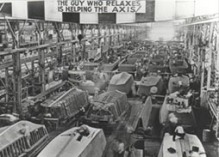"But it is Higgins himself who takes your breath away as much as his remarkable products and his fantastic ability to multiply his products at headlong speed. Higgins is an authentic master builder, with the kind of will power, brains, drive and daring that characterized the American empire builders of an earlier generation."
-FDR’s former adviser Raymond Moley in Newsweek in 1943.
-FDR’s former adviser Raymond Moley in Newsweek in 1943.
(click photos to enlarge)
Social Change: Higgins Homes & Civil Rights
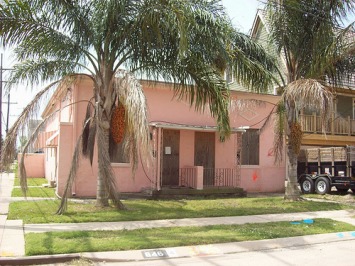
Higgins Home, Preservation Resource, 2009
Employee Housing, Daycare, and Recreation Centers
Higgins changed employer-employee relations through housing, daycare and recreation centers. By late 1943, Higgins' eight New Orleans plants employed more than 25,000 workers, creating housing shortages. Higgins convinced Federal Public Housing Authority to provide employee housing and directed the employees' housing project, named Ourtown, which grew to 750 units by July 1944.
Higgins and his sister Joy Montgomery Higgins also created child care and recreation centers for employees and their children; Higgins understood that his workers would be happier and more productive if their children were well cared for.
Higgins changed employer-employee relations through housing, daycare and recreation centers. By late 1943, Higgins' eight New Orleans plants employed more than 25,000 workers, creating housing shortages. Higgins convinced Federal Public Housing Authority to provide employee housing and directed the employees' housing project, named Ourtown, which grew to 750 units by July 1944.
Higgins and his sister Joy Montgomery Higgins also created child care and recreation centers for employees and their children; Higgins understood that his workers would be happier and more productive if their children were well cared for.
First Equal Opportunity Employer
Higgins changed employment policies: he was the first equal opportunity employer with a racially integrated work force in New Orleans; he was a leader in civil rights well ahead of his time. He staffed his plants with a diversity of employees including women, males who hadn't been drafted, elderly, blacks, and handicapped. As Strahan states, "Regardless of race, sex, age, or physical disability, all were paid equal wages according to their job rating." Higgins also hired 280 disabled veterans, some of whom were totally blind. Higgins' workers responded to his fair practices by shattering production records.
Higgins changed employment policies: he was the first equal opportunity employer with a racially integrated work force in New Orleans; he was a leader in civil rights well ahead of his time. He staffed his plants with a diversity of employees including women, males who hadn't been drafted, elderly, blacks, and handicapped. As Strahan states, "Regardless of race, sex, age, or physical disability, all were paid equal wages according to their job rating." Higgins also hired 280 disabled veterans, some of whom were totally blind. Higgins' workers responded to his fair practices by shattering production records.
Military Change: Higgins Boat & Warfare Tactics
Inventor and holder of 30 patents pertinent to amphibious landing craft and vehicles, Higgins forever changed the strategy of modern warfare tactics. Because of his innovative landing craft, Allies no longer had to batter well-fortified ports. Higgins' LCVPs gave troops the capability to transport thousands of troops and equipment in swift ship to shore movements to less-protected beaches.
The U.S. Military continued to use Higgins' LCVPs in both the Korean and Vietnam conflict.
The U.S. Military continued to use Higgins' LCVPs in both the Korean and Vietnam conflict.
Production Changes
By August 1940, Higgins Industries was the first boat manufacturer to do the following: use mass-production techniques to build landing craft; build on the second floor and then lower boats by elevator to railroad cars beneath for faster transport. During 1943, Higgins' seven plants produced more landing craft than all the other shipyards in the nation combined. Michigan Senator Homer Ferguson, member of the Truman Committee, declared Higgins was the number one boat builder in the nation.
At the peak of production, Higgins Industries operated 24 hours a day, producing more than 700 boats a month, with a total output of 20,094 boats for the Allies during World War II. Higgins Industries production record was recognized several times, receiving the Army-Navy "E", the highest award that the armed forces could bestow upon a company. By 1943, the American navy totaled 14,072 vessels, of which 12,964, or 92% of the entire U.S. Navy, were designed by Higgins Industries; 8,865 were built at the Higgins plants in New Orleans.
At the peak of production, Higgins Industries operated 24 hours a day, producing more than 700 boats a month, with a total output of 20,094 boats for the Allies during World War II. Higgins Industries production record was recognized several times, receiving the Army-Navy "E", the highest award that the armed forces could bestow upon a company. By 1943, the American navy totaled 14,072 vessels, of which 12,964, or 92% of the entire U.S. Navy, were designed by Higgins Industries; 8,865 were built at the Higgins plants in New Orleans.
"Rosie the Riveter," by Redd Evans and John Jacob Loeb, 1943

